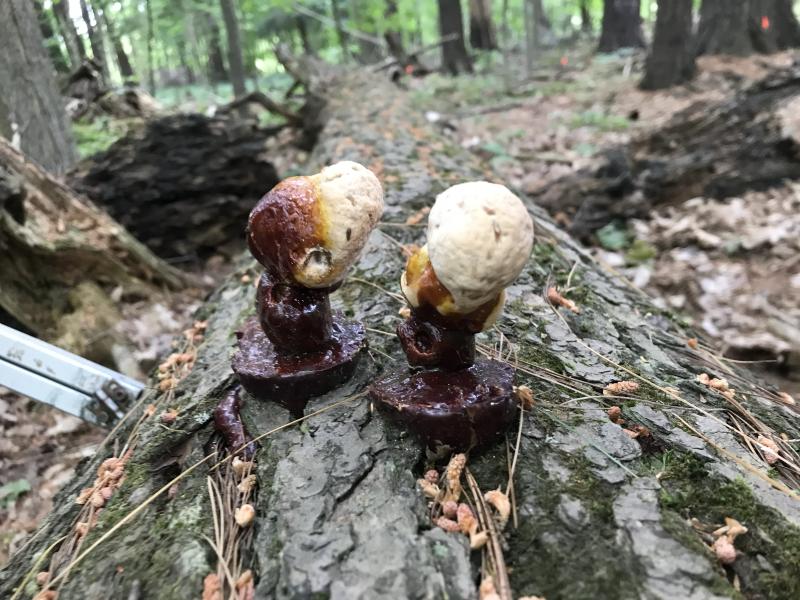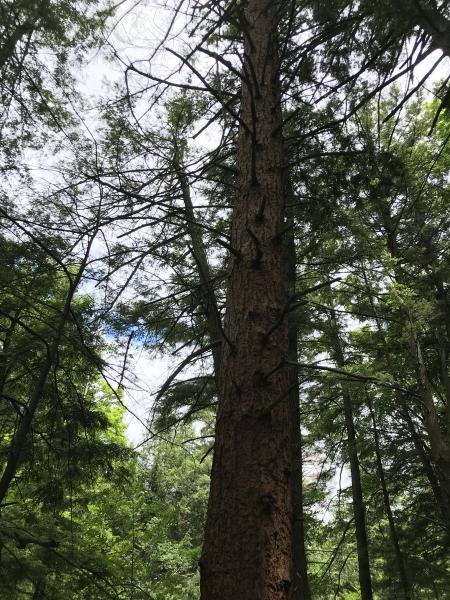
Skaná:ta “One village”
Boyd Wiiyaasidakoni Akiing
Location
GPS Coordinates
Boyd Conservation Area is a 401-hectare urban park located in the river valley of the East branch of the Humber River. Managed by the Toronto Region Conservation Authority, the park has multiple picnic areas and a trail system that winds through the various ecosystems of the Humber River Valley.
Located at the transition zone between the Carolinian Forest and Great Lakes-St. Lawrence Forest regions, Boyd Conservation area is composed of interspersed patches of deciduous and mixed forests, with species representative of both forest regions.
The Carolinean patches consist of deciduous stands dominated by ash and red pine in the canopy, interspersed with black locust and Norway spruce. Strictly a Carolinean species, the black locusts at Boyd are growing at the northernmost edge of their range. The understory is dominated by chokecherry, another Carolinian species, and buckthorn, which is an invasive shrub from Europe. The ground-layer is composed of herbaceous woodland plants such as cleavers, avens and asters, as well as spiked sedge and tree seedlings.
Representatives of the Great Lakes-St. Lawrence region include beech and maple hardwood forests, and mixed forests of sugar maple, black maple, white pine, and hemlock. Ground vegetation in beech and maple hardwood stands include false Solomon’s seal, trilliums, Jack-in-the-pulpit, and bloodroot, while mixed-wood understories are dominated by the intermediate wood fern, long stalk sedge, and Canada mayflower.
Boyd Conservation area lies on the route of the west branch of the historic Toronto Carrying Place portage, which was a 46 km trail used by Indigenous peoples, including the Huron-Wyandot, the Haudenosaunee, and the Mississauga, to travel from the north shore of Lake Ontario to the Holland River and Lake Simcoe. The trail winds along the top of the Humber River valley and connects to the Iroquois trails to the south and, by water, to Lake Couchiching in the north. Thus, the Carrying Place trail is one in a system of numerous pre-contact Indigenous trails that spanned the Americas and facilitated long distance travel, trade economy, political diplomacy, kinship-making, and warfare.
Several historic Indigenous settlements and villages are located in the present area of Boyd, including the Seed Barker and Skandatut villages. These settlements were occupied by the Huron-Wyandot during the 16th and possibly the early 17th Centuries. The Seed Barker site was first excavated in 1895 by Rowland Orr, the last person to hold the title of Provincial Archaeologist in Ontario, and was revisited from 1951 and onwards, serving as an important component of the Boyd Archaeological Field School. Archaeological excavations at Seed Barker have uncovered more than one million artifacts. Descriptions of these excavations suggest that it was a palisaded settlement consisting of at least 7 longhouses, with evidence of 13 structures. Residents of the Seed Barker village cultivated maize, sunflower, beans, and gourds (squash). Furthermore, fruits such as strawberry, nightshade, raspberries and blackberries consisted of a significant part of the residents’ diets. Animal protein came predominantly from white tailed deer, and was supplemented by fish, birds and waterfowl. Domesticated dogs were also present. The Huron-Wyandot rotated village sites every couple of decades, to let soil lay fallow, and switch hunting and fishing areas. Skandatut, which was also a palisaded village, was likely settled by Seed Barker residents following the abandonment of the Seed Barker village. During peak occupation, Skandatut was home to more than 2000 people living in 100 longhouses.
Boyd conservation park website: https://trca.ca/parks/boyd-conservation-area/
The Indigenous History of Tkaronto: https://guides.library.utoronto.ca/Toronto
Johnson, Lorraine. 2007. The Natural Treasures of Carolinian Canada: Discovering the Rich Natural Diversity of Ontario’s Southwestern Heartland. Carolinian Canada Coalition.
Teichroeb, Janice. REVISITING SEED-BARKER: A 16TH CENTURY IROQUOIAN VILLAGE SITE | Janice Teichroeb | 2 updates | 7 publications | Research Project (researchgate.net)
| English | Latin | Kanienʼkéha | Anishinaabemowin |
|---|---|---|---|
| Bitternut Hickory | Carya cordiformis | o’nón:na, ontsí:kahwe, yohso'kwatskà:rat | mitigwaabaak (-ook, plural) |
| Green Ash | Fraxinus pennsylvanica | kaneróhon | emikwaansaak, aagimaak, bwoyaak |
| Manitoba Maple | Acer negundo | kahwisto’kéha wáhta | adjagobi’mak |
| Black Maple | Acer nigrum | (check this) | makadeaanzo ninaatig |
| Red Maple | Acer rubrum | ka’takén:ra | zhiigmewanzh, zhiishiigimiiwanzh (-iik, plural) |
| Sugar Maple | Acer saccharum | wáhta’, ohwáhta | ininaatik, ininaatig (-oog, plural) |
| Burdock | Arctium lappa | ohrohte’kó:wa | zagdebwe, zadebwe |
| Jack-in-the-pulpit | Arisaema triphyllum | tyehnónhserote, kyehnónserote, kárhon, tsyorákares, tsorákares, kahnéhserote, okwá:rot nikarhonksherá:'a | zhaashaagomin |
| Bitternut Hickory | Carya cordiformis | o’nón:na, ontsí:kahwe, yohso'kwatskà:rat | mitigwaabaak (-ook, plural) |
| Blue Cohosh | Caulophyllum thalictroides | karhakón:ha, kahrhatakon | kwemshkiki, be'cigodji'bigak, bezhigojiibik, zhiigimewibag |
| Intermediate Wood Fern | Dryopteris intermedia | yetskarónhkwa, onitskerónhkwa, yetskaronhkwa'kó:wa | naanaaganashk (-oon), mzise miijim |
| Broad-leaved Helleborine | Epipactis helleborine | (check this) | (check this) |
| American Beech | Fagus grandifolia | yotyentatí:wen | gawe’mic, sewe-miins |
| Green Ash | Fraxinus pennsylvanica | kaneróhon | emikwaansaak, aagimaak, bwoyaak |
| Spotted Jewelweed | Impatiens capensis | ietsi'erorókhstha, yetsi'erorókhstha | gzhiibosegaateaa, makikiibag, wesa’wasga’skonek, ozaawashkojiibik |
| False Solomon’s Seal | Maianthemum racemosum | kítkit o'éta | agongseminan, agongosimizh, agong’osiminan |
| Virginia Creeper | Parthenocissus quinquefolia | kontiráthens | mnidoo- biimaakwad bebaamooded |
| Red Pine | Pinus resinosa | onehtóya | baakawangemaakook, bapakwanagemag |
| White Pine | Pinus strobus | tyonerahtase'kó:wa, onehta'kó:wa, ohnehta’kó:wah | biisaandago-zhingwaak, zhingwaak, shingwaak |
| Black Cherry | Prunus serotina | é:ri, e:ri’kó:wa, tyotyò:ren | ookweminagaawanzh, ookweminan, ikwe'mic |
| Chokecherry | Prunus virginiana | tyakonya’tawén:’eks, teyakonya’tawén:’eks | asasaweminagaawanzh, asasaweminan, baakinminaan, asasaweminogaawangh |
| Prickly Gooseberry | Ribes cynosbati | tyorenatsí:yo, ohrá:ton, anáduma:o:náhi | zhaabo-miinashkoon, zhaaboomin (-aak, plural), me’skwacabo’minak, kaawe-saba, Zhaaboominagaawanzh/iig "going through/piercing berr plant/s or shrub/s" |
| Black Swamp Gooseberry | Ribes lacustre | tyorenatsí:yo, ohrá:ton, anáduma:o:náhi | zhaabo-miinashkoon, zhaaboomin (-aak, plural), me’skwacabo’minak, kaawe-saba |
| Bloodroot | Sanguinaria canadensis | tekanekwas, tekané:kwaks, tekanekwénhshya'ks | miskwi- chiibikoon |
| Calico Aster | Symphyotrichum lateriflorum | teyonerahtawe'éhston, yotsiron’onhkóhare orón:ya | name'gosiibag |
| Dandelion | Taraxacum officinale | tekaronhyaká:nere | mindemoyanag, doodooshaaboojiibik, mindimooyenh, wezaawaaskwaneg |
| Tall Meadow Rue | Thalictrum pubescens | otsi’tsyakérha | (check this) |
| Red Trillium | Trillium erectum | tsyonà:tsya onekwénhtara niyotsi’tsyò:ten, áhsen niioneráhtonte | moonigohn, ininiiwindibiigegan, ini'niwin'digige'gun |
| White Trillium | Trillium grandiflorum | tsyonatsyakén:ra niyotsi’tsyò:ten, tsyoná:tsik, áhsen niioneráhtonte | ininiiwindibiigegan, baashkindjibgwaan, baushkindjibgwaun, ini'niwin'digige'gun |
| Eastern Hemlock | Tsuga canadensis | onen’ta’ón:we | gaagaaimizh, baagoodag, mitg, gaagaagiwa/inzh |

